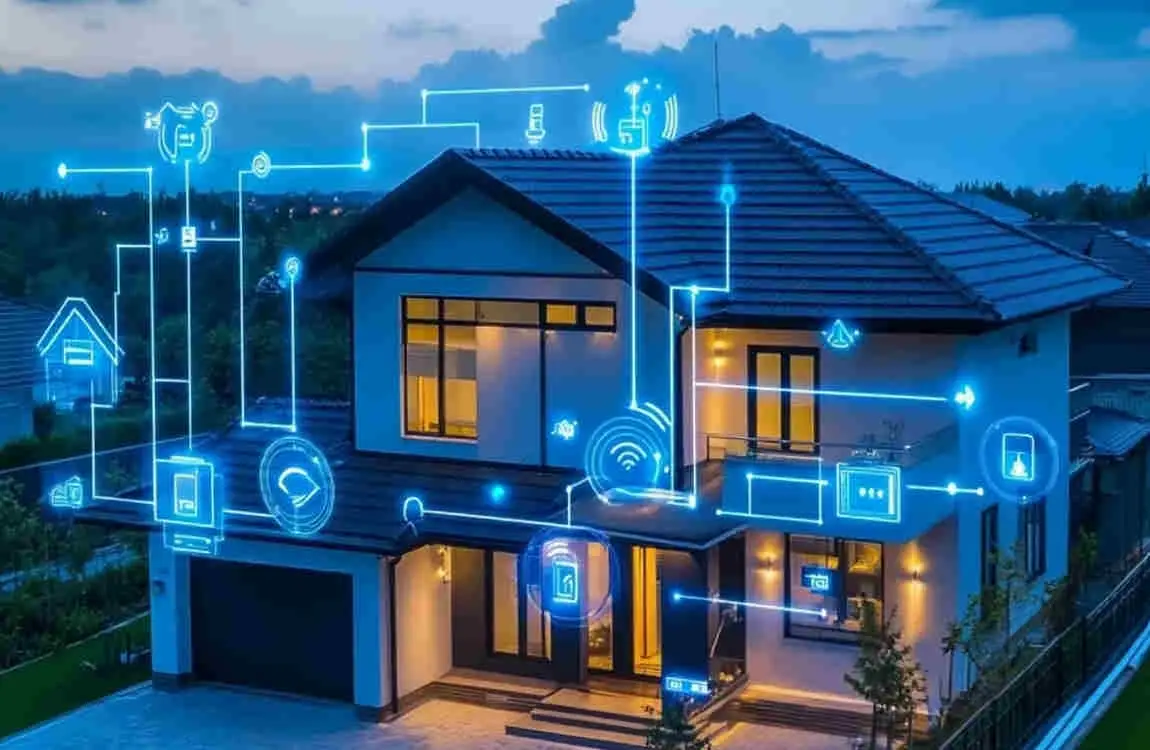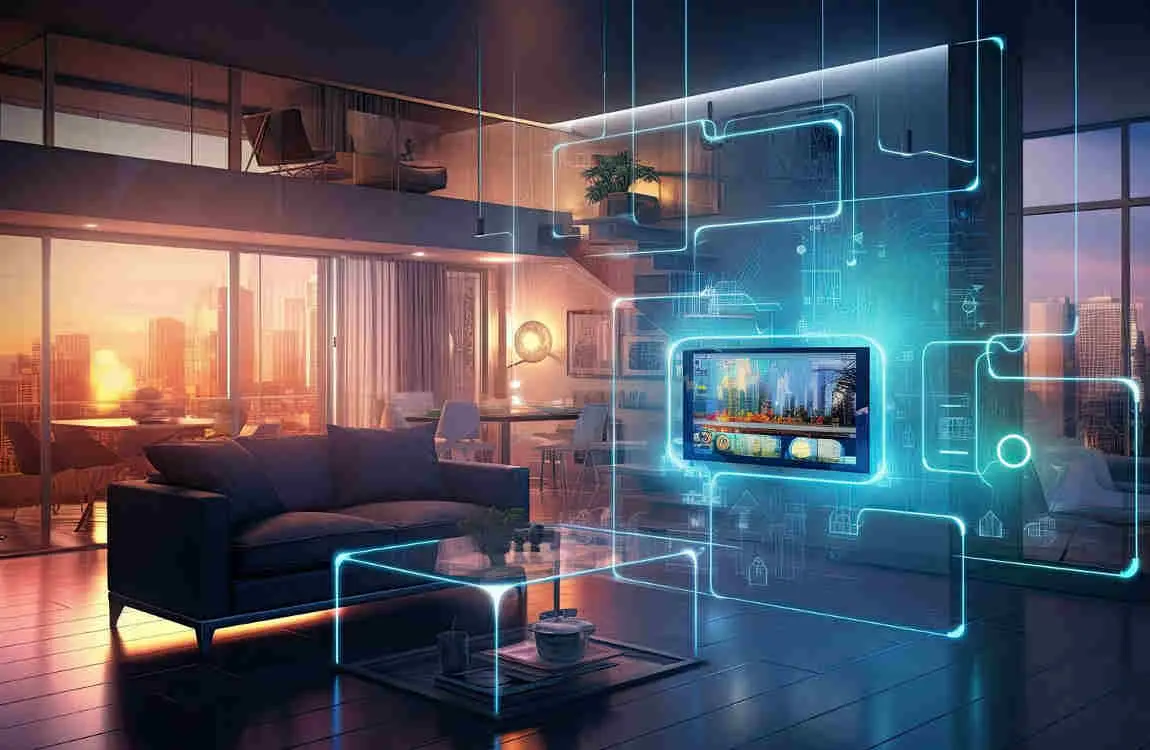Imagine coming home after a long day at work. As you walk through the door, the lights turn on to your favorite setting, and the thermostat adjusts to the perfect temperature. Your favorite music starts playing, and your intelligent assistant welcomes you back. This isn’t a scene from a sci-fi movie; it’s the reality of living in a smart home.
Understanding Smart Home Technology

What is a Smart Home?
A smart home is a residence that uses internet-connected devices to enable remote monitoring and management of appliances and systems. These devices communicate with each other and can be controlled via a smartphone app or voice commands.
Core Components of a Smart Home
- IoT Devices: These are the physical devices that make up your smart home, such as bright lights, thermostats, and Security cameras.
- Central Hub: The brain of your smart home, connecting all your devices and enabling them to communicate with each other.
- AI Integration: Artificial intelligence is what makes your smart home truly “smart,” allowing it to learn your preferences and automate tasks.
Popular Smart Home Gadgets
- Bright Lights: Control the color, brightness, and schedule of your lights from anywhere.
- Smart Thermostats: Optimize your home’s temperature for comfort and energy efficiency.
- Smart Security Systems: Monitor your home remotely and receive alerts if something unusual happens.
- Smart Appliances: From refrigerators to washing machines, these devices can be controlled and monitored remotely.
Benefits of a Smart Home
- Convenience: Control your home from anywhere with a tap or a voice command.
- Security: Keep an eye on your home and receive instant alerts if something’s amiss.
- Energy Efficiency: Save money on your utility bills by optimizing your home’s energy use.
- Lifestyle Improvement: Create the perfect living environment tailored to your needs and preferences.
AI-Powered Innovations in Smart Homes
How AI Enhances Smart Home Functionality
AI is the secret sauce that makes your smart home truly intelligent. It can learn your habits, anticipate your needs, and automate tasks to make your life easier.
AI Voice Assistants
- Alexa: Amazon’s AI assistant can control your smart home devices, play music, and answer your questions.
- Google Assistant: Google’s AI assistant offers similar functionality, with the added benefit of integration with Google’s ecosystem of services.
- Siri: Apple’s AI assistant can control your smart home devices and integrate with other Apple products.
Smart Learning Thermostats
- Nest: This thermostat learns your temperature preferences and creates a schedule to optimize comfort and energy savings.
- Eco bee: Like Nest, it offers remote sensors to monitor temperatures in different rooms.
Predictive Maintenance with AI Sensors
AI sensors can monitor the health of your appliances and systems, predicting when maintenance or repairs are needed. This can save you money and prevent unexpected breakdowns.
AI in Home Security
- Facial Recognition: AI can identify familiar faces and grant access to your home.
- Smart Cameras: AI-powered cameras can detect unusual activity and send you alerts.
- Intelligent Alerts: AI can filter out false alarms and only notify you of genuine Security concerns.
Examples of AI in Daily Home Management
- Automated Lighting: AI can learn your lighting preferences and turn lights on and off based on your schedule.
- Smart Appliances: AI can optimize appliance performance, such as adjusting the temperature of your refrigerator based on its contents.
- Personalized Entertainment: AI can recommend movies, music, and other content based on your tastes and mood.
Energy Savings and Sustainability in Smart Homes
The Role of Smart Home Tech in Reducing Energy Consumption
Smart home technology can help you save money on your utility bills while also reducing your carbon footprint. By optimizing your home’s energy use, you can make a positive impact on the environment.
Smart Lighting Systems
- Motion Sensors: Lights can turn on automatically when you enter a room and turn off when you leave.
- Adaptive Brightness: Lights can adjust their brightness based on the time of day and the amount of natural light in the room.
- Schedule Control: You can set schedules for your lights to turn on and off at specific times, even when you’re not home.
Energy-Efficient Smart Thermostats and HVAC Integrations
Smart thermostats can learn your temperature preferences and create a schedule to optimize comfort and energy savings. They can also integrate with your HVAC system to further improve efficiency.
Solar Panel Integration and Smart Energy Monitoring
If you have solar panels, smart home technology can help you monitor your energy production and consumption in real-time. This can help you make the most of your solar investment and reduce your reliance on the grid.
Smart Plugs and Appliances
Smart plugs can monitor the energy use of your appliances and turn them off when they’re not in use. Smart appliances can also optimize their energy use, such as running the dishwasher during off-peak hours.
Environmental Benefits and Cost Savings
By adopting smart home energy tech, you can reduce your carbon footprint and save money on your utility bills. Over time, these savings can add up to significant amounts.
Tips for Maximizing Energy Savings
- Audit Your Home: Identify areas to improve energy efficiency, such as sealing drafts and upgrading insulation.
- Set Schedules: Use smart home technology to schedule your devices and appliances to optimize energy use.
- Monitor Your Usage: Keep an eye on your energy consumption and adjust your habits and settings accordingly.
- Invest in Energy-Efficient Appliances: When it’s time to replace an appliance, choose an energy-efficient model to save money in the long run.
Wellness Technology in Smart Homes

The Emerging Role of Wellness Tech
Smart home technology isn’t just about convenience and energy savings; it’s also about improving your health and well-being. Wellness tech is an exciting new frontier in smart home innovation.
Air Quality Monitoring and Smart Purifiers
Smart air purifiers can monitor your home’s air quality and automatically adjust their settings to keep the air clean and fresh. Some models can even detect specific pollutants and allergens.
Sleep Tech Integration
- Innovative Mattresses: These mattresses can monitor your sleep patterns and adjust their firmness and temperature to optimize your sleep.
- Bright Lighting: Smart lights can be programmed to mimic the natural light cycle, helping you fall asleep and wake up more easily.
- Bright Sound: Smart speakers can play soothing sounds to help you relax and fall asleep.
Smart Water Systems
- Hydration Reminders: Smart water bottles and dispensers can remind you to stay hydrated throughout the day.
- Leak Detection: Smart sensors can detect leaks and shut off the water supply to prevent damage.
- Water Purification: Smart water purifiers can monitor water quality and automatically adjust settings to keep it clean and safe.
Personal Health Monitoring and Fitness Integration
Smart home devices can monitor your vital signs, such as heart rate and blood pressure, and integrate with fitness apps to help you track your progress and reach your goals.
Mental Health and Relaxation Tech
- Smart Lighting Mood Settings: Smart lights can be programmed to create different moods and atmospheres, such as calming blue for relaxation or energizing yellow for productivity.
- AI-Based Meditation Aids: AI-powered meditation apps can guide you through meditation sessions and provide personalized recommendations based on your mood and needs.
How Wellness Tech Boosts Comfort and Health
By integrating wellness tech into your smart home, you can create a living environment that supports your health and well-being. From better sleep to improved air quality, these technologies can make a real difference in your daily life.
Choosing and Integrating Smart Home Devices
Selecting the Right Smart Home Devices
With so many smart home devices on the market, choosing the right ones for your needs can be overwhelming. Here are some tips to help you make the best decision:
- Identify Your Needs: Think about what you want to achieve with your smart home, such as energy savings, Security, or wellness.
- Research and Compare: Review products and compare features and prices to find the best devices for your needs.
- Start Small: Begin with a few key devices and build your smart home gradually.
Compatibility Considerations
When choosing smart home devices, make sure they’re compatible with each other and with your existing systems. Look for devices that work with popular platforms like Amazon Alexa, Google Assistant, or Apple Home Kit.
Security and Privacy
As with any internet-connected device, Security and privacy are important considerations when setting up a smart home. Look for devices with strong encryption and secure authentication methods, and be sure to change default passwords and keep your software up to date.
Practical Tips for Integration
- Start with a Central Hub: A central hub can help you manage and control all your smart home devices from one place.
- Label Your Devices: Use clear, descriptive names to make them easy to identify and control.
- Create Routines: Set up routines to automate everyday tasks, such as turning on lights and adjusting the thermostat when you come home.
Future-Proofing Your Smart Home
To ensure your smart home investment lasts, look for devices with open standards and interoperability. This will make it easier to add new devices and integrate with future technologies.
Real-Life Examples and Case Studies
Success Stories of Smart Home Transformations
- The Johnsons: By installing smart thermostats and lighting, the Johnsons reduced their energy bills by 20% and created a more comfortable living environment.
- The Smiths: After installing an intelligent Security system, they were able to monitor their home remotely and receive instant alerts, giving them peace of mind when away.
- The Garcias: By using wellness tech, such as smart air purifiers and sleep monitors, the Garcia family improved their health and well-being, leading to better sleep and fewer allergies.
